Two well-known journalists in Beijing died of the virus, and the sudden release of ties caused a surge in deaths.
WASHINGTON —
Chinese media reported on Friday (December 16) that two senior journalists of Chinese state media had died in Beijing after being infected with the Omicron strain. This is the first death case reported by the Chinese media after the Chinese government abandoned the zero-clearing policy without warning, preparation, and planning.
One of them is Yang Lianghua, a well-known former reporter from People's Daily. He was 74 years old and died on Thursday. The other person is Zhou Zhichun, former vice president and deputy editor-in-chief of China Youth Daily, who died of illness on December 8 at the age of 77.
China's National Health Commission has stopped publishing death figures since December 7, when China lifted its lockdown. The last reported death was on December 3.
However, information published on social media shows that the number of deaths from the virus in China is increasing rapidly. There are too many corpses piled up in Beijing crematoriums to be burned in time, and the queues for cremation are very long, usually taking several days. Some residents reported that because the queue was too long, after their family members died of illness, their bodies could not be sent out, so they had to be kept at home for several days.
On the day the media reported the deaths of the two journalists, China's National Health Commission issued emergency plans to protect rural communities. The Chinese New Year is approaching, and a large number of migrant workers will leave the city and return to the countryside to celebrate the New Year. Experts warn that the epidemic will rise in rural areas two to six weeks after the Spring Festival, and will rise again in cities after migrant workers return to cities one to two months after the Spring Festival.
About 500 million of China's 1.4 billion people live in rural areas. The medical resources of China's small towns and rural communities are far behind that of big cities like Beijing and Shanghai. There are roughly 17,000 county-level hospitals in rural China, which suffer from a severe shortage of beds, especially emergency beds.
The National Health and Medical Commission of China proposed in the Strengthening the New Coronary Pneumonia Epidemic Prevention and Control and Health Service Work Plan in Rural Areas to speed up the vaccination of rural populations, especially the elderly, and increase the supply of ventilators, major drugs, and test kits in rural areas. Reserve and persuade travelers to reduce contact with the elderly.
In the past three years, China has been implementing the zero-zero anti-epidemic policy formulated by Xi Jinping, and the continuous implementation of city closures across the country has caused widespread and serious humanitarian disasters and huge economic costs.
Last week, the Beijing authorities suddenly changed their policy and loosened their control over the people, which caused great excitement in the whole society. However, this excitement was quickly cooled by the chaos brought about by the disorderly release, and people were at a loss because of their lack of preparation for the rapid deterioration of the epidemic.
Just the day before (Thursday), the White House stated that the United States is willing to help China fight the epidemic if China requests it. The Australian Ministry of Foreign Affairs also expressed its readiness on Friday to cooperate with China in providing medical supplies or other assistance.
However, Chinese Foreign Ministry spokesman Wang Wenbin did not respond positively when answering related questions at a press conference on Thursday, only emphasizing that China has institutional advantages.








